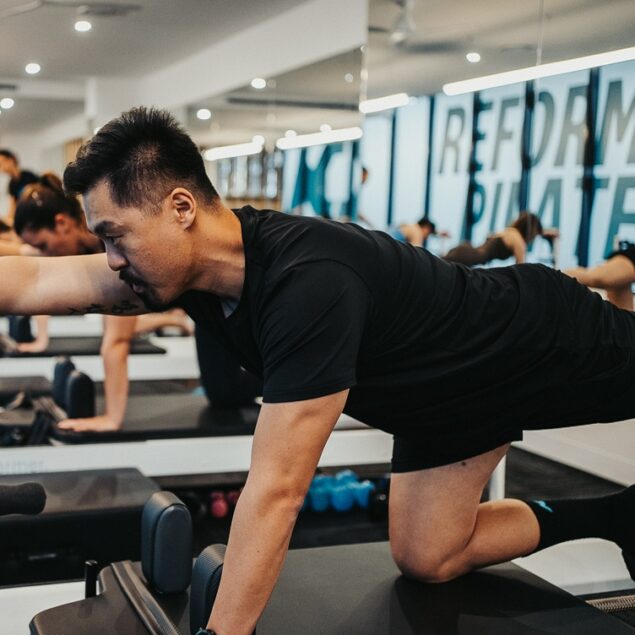
Starting your fitness journey can feel like a leap into the unknown, but you don’t have to go into it blindly. Reformer Pilates offers a structured and supportive way to ease into fitness, focusing on building stability, core strength and overall well-being.
In this guide, we’ll explore the benefits of Reformer Pilates and key techniques that lay the foundation for a more sustainable fitness journey.
Reformer Pilates is a versatile and dynamic form of exercise that uses a specialised piece of equipment called a reformer. This apparatus features a gliding platform, springs for adjustable resistance and a combination of ropes and pulleys, allowing for a wide range of controlled movements. Whether you’re lying, sitting or standing, the reformer facilitates exercises that target specific muscle groups while promoting balance and core stability.
What sets Reformer Pilates apart is its focus on precise, low-impact exercises that support optimum alignment and functional strength. By emphasising control, flow and breathwork, Reformer Pilates helps enhance overall body awareness and coordination, leaving you feeling challenged, refreshed and confident after every session.
With consistent practice, Reformer Pilates offers a range of advantages, particularly for those new to fitness:
Joseph Pilates, the founder of Pilates, described the core as the body’s “powerhouse,” including the abdominals, back and pelvic floor muscles. It’s where all energy originates and extends outward to the extremities.
In Reformer Pilates, every movement aims to activate the core to enhance spinal support and overall balance. The reformer’s spring-loaded resistance adds a unique challenge, requiring your core muscles to remain stabilised during exercises like leg presses, planks or upper body movements. Consistent core activation creates a strong foundation that supports all your daily activities.
Reformer Pilates offers a well-rounded workout that combines strength, flexibility and balance in a low-impact format. Unlike traditional strength training, which often focuses on progressive overload to build muscle mass through compound and isolated movements, Reformer Pilates prioritises muscular endurance, core stability and functional movement.
The versatility of the reformer makes it a fantastic choice for a full-body workout on its own. Its precise, controlled movements engage multiple muscle groups in the core, lower body and upper body all at once, delivering a comprehensive and effective fitness experience.
Research suggests that Pilates is a promising method for addressing posture and spinal deformities. Activating the deep muscles of the core and spine, Pilates helps support alignment and encourages better body awareness. However, its effectiveness relies on consistent practice, proper technique and tailoring the approach to individual needs.
In Pilates breathwork is a fundamental practice that supports, energises and aligns the body throughout each movement. By using intentional breathing patterns, you can enhance your technique and deepen your connection between mind and body.
Breathwork isn’t just essential in Pilates. Whether you’re lifting weights, running or practising yoga, controlled breathing ensures you stay grounded and in control of your movements.
Your first Pilates class provides a low-impact introduction to fitness. The reformer machine’s adjustable spring system enables smooth movements, reducing the risk of injury or muscle strain. Unlike high-intensity exercises that involve repetitive impact, Reformer Pilates promotes functional endurance and flexibility in a safe and supportive way.
Poor posture can lead to overcompensation or stress in certain areas of the body during workouts, which over time can hinder progress and even cause discomfort or long-term issues.
To help improve posture, here are some essential Reformer Pilates exercises. These movements may need to be modified based on your fitness level and experience, so it’s always a good idea to seek guidance from a qualified trainer to ensure you perform them safely and effectively.
1. The hundred
The Hundred is a classic Reformer Pilates exercise that strengthens the core and back muscles to support better posture. To perform it:
2. Spine stretch forward
This exercise helps lengthen the spine and minimise tension in the hamstrings and lower back. It also may enhance posture by increasing awareness of spinal alignment.
Here’s how to do it:
Balance is a core component of any fitness routine. It helps your muscles, joints and nervous system work more efficiently, reducing the risk of falls and making your routines smoother and safer.
Here are reformer techniques that help promote better balance:
1. Reformer short box twist
The Short Box Twist is an excellent exercise for targeting the oblique muscles and boosting spinal flexibility and balance. Here are the steps:
2. Reformer plank
This classic full-body exercise engages both your front and back muscles, working together to support your body weight while maintaining a straight line from head to heels. If the front muscles are under-engaged, the body may dip, while over-engagement can cause the hips to lift too high.
On the reformer, the plank becomes even more demanding due to the moving carriage. But when done correctly, it helps you improve balance, range of motion and abdominal strength.
Starting your fitness journey with Reformer Pilates sets the stage for a stronger, more adaptable body. While Pilates can seem intimidating at first, working with experienced trainers can make all the difference.
At KX Pilates, we combine expert instruction with a personalised approach to help you maximise the benefits of Reformer Pilates. Our classes are designed to suit all skill levels and help you build a fitness foundation. We also offer comprehensive courses for aspiring trainers.
Book your first class today and transform your long-term health and well-being.